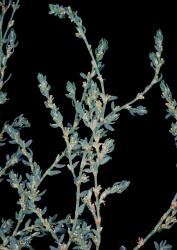- Taxon
- Gallery
- ≡ Polygonum aviculare subsp. depressum (Meisn.) Arcang. (1882)
- = Polygonum aviculare var. depressum Meisn.
- = Polygonum aequale Lindm. (1912)
Glabrous annual, prostrate or decumbent, often forming dense leafy mats; stems to c. 70 cm long; taproot fairly stout. Lvs of young and main stems similar or slightly > those of branches, subsessile or very shortly petiolate. Lamina 7–15 × 2–6 mm, narrow-elliptic to elliptic or elliptic-oblong, sometimes broader in very small-leaved plants, green, entire; lateral veins evident beneath; base cuneate to rounded; apex obtuse to subacute; apical branch lvs sometimes < 5 mm long. Ochreae initially 2–4 mm long, silvery-hyaline, ± acute, often tinged pink, becoming brown and lacerate. Fls 1–3–(6) in fascicles, extending almost to base of plant; pedicels short, enclosed by ochreae. Perianth 2–3 mm long, usually united at anthesis for ?-1/2 length; segments imbricate, ± oblong, glabrous, accrescent; margins and apex generally white, sometimes rose. Nut 1.7–2.5 mm long, generally ovoid but ranging from ± biconvex to ± trigonous, dark reddish brown, granular but ± shining, enclosed in perianth.
[From: Webb et al. (1988) Flora of New Zealand. Volume 4.]
Flowering: Nov.–Jun.




